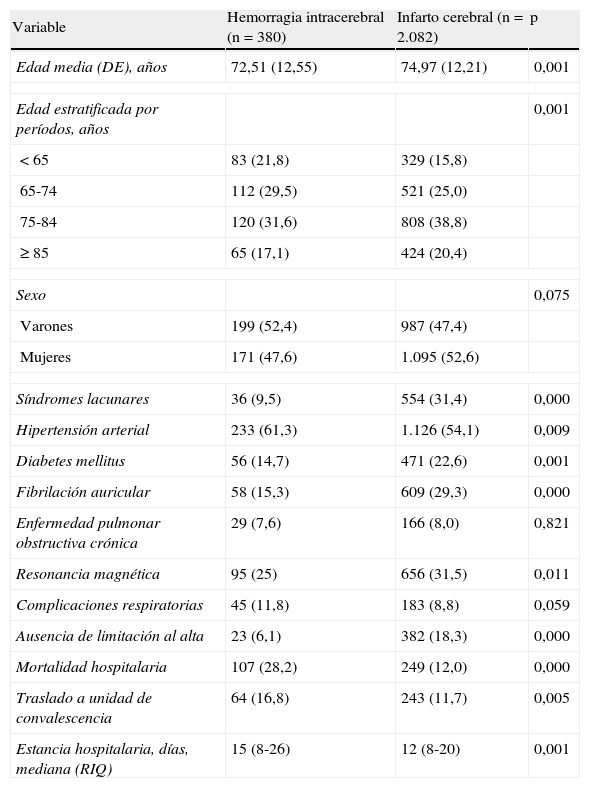Analizar las variaciones de los factores de riesgo y el perfil clínico de las hemorragias intracerebrales no traumáticas (HIC) entre 1986 y 2004 a partir del registro de ictus del Hospital del Sagrat Cor, y comparar los datos de las HIC con los de los infartos cerebrales.
Pacientes y métodoEstudio hospitalario de 380 pacientes consecutivos con HIC y 2.082 pacientes con infarto cerebral. Se efectúa un análisis comparativo de las tendencias y variaciones clínicas observadas entre los períodos 1986-1992, 1993-1998 y 1999-2004.
ResultadosLa edad se incrementó significativamente (p<0,001) durante los 3 períodos de estudio y se observó un aumento significativo en la frecuencia de fibrilación auricular, enfermedad pulmonar obstructiva crónica (EPOC) y de topografía cerebral lobular. El uso de la resonancia magnética (RM) cerebral también aumentó de forma significativa a través del período de estudio. En comparación con los infartos cerebrales, en las HIC fue más frecuente la mortalidad hospitalaria (28,2 frente al 12%) y menos habituales la presencia de un síndrome lacunar (9,5 frente al 31,4%) y la ausencia de sintomatología neurológica al alta hospitalaria (6,1 frente al 18,3%).
ConclusionesSe observan variaciones clínicas significativas durante dicho período de tiempo de 19 años, con un incremento en la edad de presentación, en la frecuencia de fibrilación auricular y EPOC y en el uso de la RM cerebral. La HIC constituye un subtipo de ictus grave con una mayor mortalidad precoz y una menor frecuencia de ausencia de sintomatología al alta hospitalaria en comparación con los infartos cerebrales.
Cardiovascular risk factors, clinical features and early outcome of first-ever primary intracerebral haemorrhage (PIH) from 1986 to 2004 using the Sagrat Cor Hospital of Barcelona Stroke Registry were assessed, and compared with data from patients with first-ever ischemic stroke.
Patients and methodsThe study population consisted of 380 patients with PIH and 2,082 patients with ischemic stroke. Secular trends for the periods 1986-1992, 1993-1998 and 1999-2004 were analyzed.
ResultsAge increased significantly (P<.001) throughout the 3 study periods and there was a significant increase in the percentage of patients with atrial fibrillation, chronic obstructive pulmonary disease (COPD) and lobar topography. The use of brain magnetic resonance imaging (MRI) also increased significantly throughout the study periods. In comparison with ischemic stroke in-hospital death was more frequent (28,2 vs. 12%) and lacunar syndrome (9,5 vs. 31,4%) and symptom-free patients at discharge were less frequent in the intracerebral haemorrhage group (6,1 vs. 18,3%).
ConclusionsSignificant changes over a 19-year period included an increase in the patient's age, frequency of COPD and atrial fibrillation and use of MRI imaging studies. PIH is a severe subtype of stroke with a higher risk of early death and lower asymptomatic frequency at discharge than ischemic cerebral infarct.
Artículo
Comprando el artículo el PDF del mismo podrá ser descargado
Precio 19,34 €
Comprar ahora








